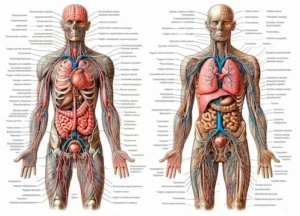Each part of the human body is made up of countless cells that have defined shapes and functions. In addition, there are tissues, organs and systems, which function in an integrated manner.
We can compare our body to a complex and perfect machine with all its parts working in sync.
Anatomy: The Study of the Human Body
Human anatomy is the area of biology that studies the structures of the human body, including systems, organs, and tissues. It also examines how body structures can be affected by genetics, environment, and time.
The human body is divided into three basic parts : head, trunk and upper and lower limbs.
The anatomical description considers that the body should be in an upright position, standing, with the face facing forward, upper limbs stretched out and parallel to the trunk, with the palms facing forward, the lower limbs should be together. This is the so-called anatomical position.
Levels of Organization of the Human Body
The human body is made up of simple structures such as cells, to more complex ones such as organs.
The level of organization of the human body is as follows: cells, tissues, organs, systems and organism. Each of these structures consists of a hierarchical level until the formation of the entire organism.
Learn more about each of the structures that make up the organization of the human body:
Cells
Cells are structures formed by three basic parts: the plasma membrane, cytoplasm and nucleus .
Each cell in the body can vary in shape (stellate, elongated, cylindrical, etc.), size and lifespan. Bone cells, for example, last several years, while skin cells renew themselves every 35 to 45 days.
Each type of cell develops to perform a function in the body. Muscle cells, for example, are capable of contracting. Red blood cells transport oxygen throughout the body. Nerve cells are capable of receiving and transmitting stimuli.
Fabrics
Human life begins with a single cell. From there, it divides and forms two new cells, which also divide and form two more, and so on.
During the formation of the fetus, in the mother’s uterus, cells develop according to their location and function in the body. This process is called cellular differentiation.
There are many types of cells in the human body, with different shapes and functions. Cells work in groups, are organized in an integrated manner, and together they perform a specific function.
These cell groups form tissues. The tissues of the human body can be classified into four types:
- Epithelial tissue
- Connective tissue
- Muscle tissue
- Nervous tissue
Organs
Tissues, like cells, are also grouped together. The set of tissues that perform a certain function is called an organ. In general, an organ is formed by different types of tissues.
Several organs make up the human body, including the heart, lungs, brain, stomach, intestines, liver, pancreas, kidneys, bones, spleen, eyes, etc. Most of the organs are located in the trunk region.
The skin is the largest organ in the human body.
Systems
A set of organs that act in an integrated manner constitutes a system. The systems of the human body perform specific functions, but they act in an integrated manner.
The human body is made up of several systems: respiratory, circulatory, digestive, cardiovascular or circulatory, muscular, nervous, endocrine, excretory, lymphatic, reproductive and skeletal.
Each system has its own specific function. The respiratory system, for example, is responsible for the body’s absorption of oxygen from the air and the elimination of carbon dioxide from cells.
Finally, the set of all functioning systems constitutes the organism that together maintains the survival of the individual.
Thus, the organism represents the highest level of organization.
Curiosities about the Human Body
- The largest bone in the human body is the femur, the thigh bone of the leg. The smallest bone is the stapes, located in the inner ear.
- An adult’s heart beats about 100,000 times a day.
- On average, 2 kg of body weight is represented by bacteria that inhabit our body.
- The kidneys filter approximately 1.3 liters of blood per minute.
- A nerve impulse can reach up to 360 km/h.
- An adult has 206 bones, while a baby has 300.
